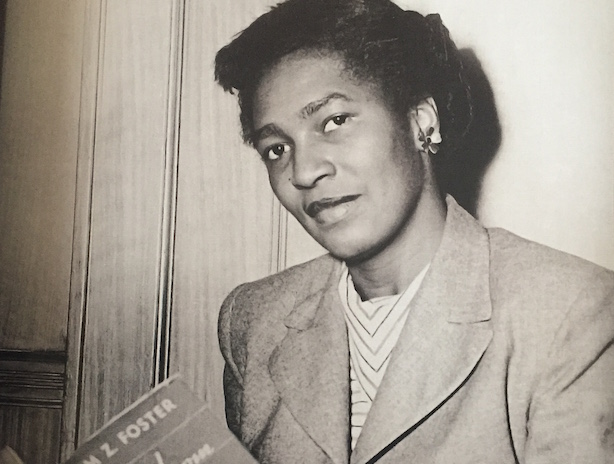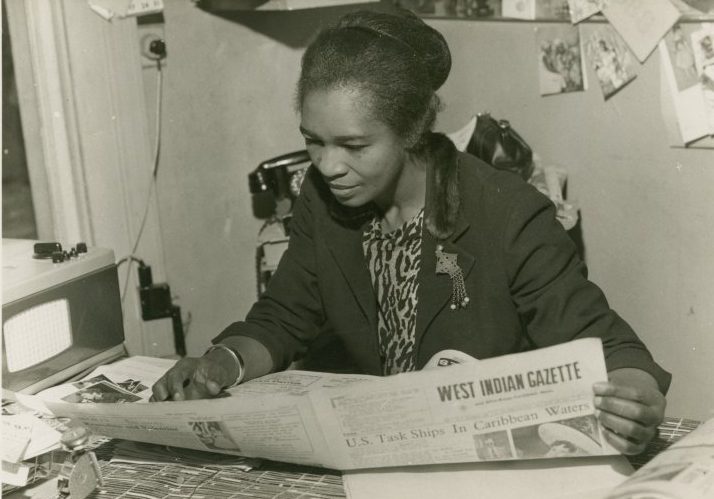The Marxist Proposition, Claudia Jones, and Black Nationalism
This post is part of our online forum, “Black October,” on the Russian Revolution and the African Diaspora

Many in the American Left hoped that a worldwide socialist revolution would follow the 1917 Bolshevik Revolution. When no revolution materialized, the Soviet Union, in an attempt to keep the revolutionary fervor alive, challenged Communists overseas to push for revolutionary change in their own countries. For Black Americans, it was the Communist International’s (Comintern) adoption of the Black Belt Nation thesis in 1928 and international communism’s pledge to fulfill the “Marxist proposition” that “no nation can be free if it oppresses other nations” that articulated the socialist promise. The Black Belt thesis defined Blacks living in the American South as an oppressed nation and argued that as a nation they had a right to self-determination. This meant that the Comintern and the US Communist Party (CPUSA) recognized Black Nationalism as a part of the communist revolutionary commitment. Claudia Jones was attracted to the Party by the thesis but also by the promises of a new “Soviet woman” who was a full citizen with access to economic independence and birth control. Jones cited the CPUSA’s commitment to the Scottsboro boy’s defense as the reason she became a member. However, she would become an important leader in defining socialism’s promise for Black women’s liberation and Black Nationalism.1
Jones, like other women that would join the CPUSA, was turned off by the masculinity that dominated Black Nationalist organizations. As a young woman, she worked at a Nationalist newspaper writing précis on the Italian assault in Ethiopia. When she went uncredited and male leaders claimed her ideas for their own, she left and turned to the CPUSA. But in the American Party, Jones was perplexed to find that its commitment to the Black Belt Nation Thesis was rhetorical at best. Jones’s vocal disappointment with Party leadership on the thesis propelled her to leadership. Though she was committed to Marxism and the revolution, she did not blindly follow its dogma. Instead, Jones challenged the Party to commit to Black Nationalism and she argued that it was Black women who were the key to liberation and thus the basis for Black Nationalism and communist revolution.2
After World War II, the Party was locked in an internal struggle. Its leader, Earl Browder, expressed doubt about Black Nationalism’s compatibility with Marxist-Leninism, arguing that American Blacks sought “complete integration” into the United States and did not want separation. Jones sided with Browder’s opposition, William Foster, and she defended Black Nationalism in her article, “On the Right to Self-Determination for the Negro People in the Black Belt.” It was also at this moment that Jones began to push the Party to rethink its strict class analysis. Jones argued that race and gender were integral components in class oppression, and were essential to any revolutionary analysis. She also insisted that self-determination did not mean separation, as a committed Marxist she sought unity between the Black community and the white working-class.3

For Jones, the “main forces” for democracy were the white working-class in alliance with Black Americans. But she recognized that to secure such an alliance, there had to be an articulation of Black Nationalism’s struggle for Black liberation and its link to working-class resistance to capitalist oppression. Jones believed that Black Nationalism would not undermine the potential for “unity of all progressives.” There required, however, an understanding that solutions to the “Negro question” required “special demands,” in addition to, not apart from, the demands of the white working classes. For Jones, the Party was at the forefront of the resistance to the greatest threat to worker’s unity, the “imperialist ideology of white supremacy.” Jones argued that the fight for Black rights was in the “self-interest” of working-class whites because to fight against white supremacy was to fight against the “ideologies and practices of America’s ruling class” which kept the white and Black working-classes apart and in competition with one another.
This she argued was in keeping with Marxist-Leninism. Stalin defined a nation as a “historically evolved, stable community of language, territory, economic life and psychological make-up manifested in a community of culture.” The Black Belt constituted an oppressed nation because Black people formed a majority and the Civil War failed to liberate them. Instead, the chains that bound the Black Belt were “the invisible chains of poverty, the legal chains of debt-slavery,” and the “iron-shackles of the chain gang.” In the Black Belt, constitutional rights became “more and more restricted” in the “main centers of Negro population” in the South. The thesis was in line with Lenin’s early attempts to put Black Americans forward as the “vanguard of the workers’ movement” since they were the most oppressed and he believed the most justifiably “angry element” in the United States.4
Jones argued that self-determination in the South meant to wipe out the remnants of slavery and enforce equal rights. This is what made self-determination crucial in the Black Belt. Blacks were not simply fighting for their basic rights, they were fighting against the perpetuation of slave status. Self-determination was not a diversion from working-class struggles, but “an aid to it.” As a communist she believed that “complete and lasting equality” was only guaranteed by the “establishment of Socialism” like in the Soviet Union. But there was no sense in waiting for Black liberation until the revolution.

It was Black women’s liberation that would be the key to the revolution. Though Jones did not coin the phrase “Triple Oppression,” she articulated it most clearly. The Triple Oppression of Black women, as workers, women, and Black, meant that their liberation would usher in the revolutionary change required for women’s, worker’s and minorities equality. For Jones, gender liberation was a crucial part to ushering in the revolution, because gender disunity was such an important tool in keeping the white and Black working-classes divided. She pointed to the so-called chivalrous claims to white womanhood that were used to lynch Black men and degrade Black women. She urged white women to “rise to challenge this lie” to undermine the whole system of Black oppression.
Even more important, that white womanhood was wielded as a weapon against Black equality proved to Jones that the “Negro question” was “prior to, and not equal to, the woman question.” Gender equality could not be achieved until Black people won full equality. Black women’s triple oppression made women the “vital link” to a “heightened political consciousness” that was needed for liberation. Jones wanted to see Black women take up leadership roles in the CPUSA to push for the Party’s “historic mission” to see a “Socialist America” modeled on the Russian Revolution. It was only a Socialist America that was the “final and full guarantee of women’s emancipation.”
In keeping with Marxist-Leninist ideology, Jones believed that socialist revolution was the only guarantee of the emancipation of women, minorities, and the working-classes and that this was evidenced in the Soviet Union. But she moved well beyond Marx to argue that Black Nationalism and women’s liberation were fundamentally different experiences than the class-based dogma to which the CPUSA adhered. It was the divisions between and among the oppressed that helped to secure capitalist domination; therefore, the Party had to address race and gender oppression. Jones was not interested in Black Nationalism as a “slogan of immediate action.” Rather, she sought to make it a “programmatic demand” and a “guiding principle” for the Party. She believed that self-determination could be a “beacon for the day to day struggles” for Black equality. Even as Jones expanded Marxist ideology, she challenged Black Nationalism to recognize that Black women’s triple oppression meant that Black women’s liberation was the crux of any nationalist program. Though Jones was certain socialism would eradicate these divisions, her belief that race issues took priority over gender and class matters meant that the liberation of the most oppressed would be the liberation of us all.
- Claudia Jones, “On the Right to Self-Determination for the Negro People in the Black Belt,” Political Affairs (January 1946): 69; Erik S. McDuffie, Sojourning for Freedom: Black Women, American Communism and the Making of Black Left Feminism (Durham: Duke University Press, 2011), 2. ↩
- Claudia Jones to William Foster, 6 December 1955. Claudia Jones Vertical File, Tamiment Library, New York University, New York. ↩
- Rebecca Hill, “Fosterites and Feminists, Or 1950’s Ultra-Leftists and the Invention of AmeriKKKa,” New Left Review 228 (1998): 34; Claudia Jones, “Discussion Article by Claudia Jones,” Political Affairs (August 1945): 717. ↩
- Claudia Jones, “On the Right to Self-Determination for the Negro People in the Black Belt,” 69; Cedric Robinson, Black Marxism: The Making of the Black Radical Tradition. (Chapel Hill: The University of North Carolina Press, 1983), 220. ↩

To the point … great read …